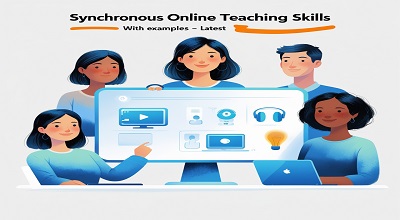Synchronous Online Teaching Skills
Synchronous online teaching skills refer to real-time, live instruction where educators and learners interact simultaneously via digital platforms like Zoom, Microsoft Teams, or Google Meet. Unlike asynchronous learning (pre-recorded lectures), synchronous teaching fosters immediate engagement, discussions, and collaborative learning.
With the rapid growth of e-learning, mastering synchronous teaching skills has become crucial for educators. This blog explores essential skills, practical examples, and the latest trends to enhance online teaching effectiveness.
Essential Synchronous Online Teaching Skills
Engagement and Interaction
Keeping students engaged in a virtual setting requires creativity. Techniques include:
- Live Q&A sessions – Encouraging students to ask questions in real-time.
- Interactive discussions – Using chat features to facilitate participation.
- Emotional check-ins – Starting sessions with a quick “How are you feeling today?” poll.
Technical Proficiency
Teachers must be comfortable with:
- Platform navigation (Zoom, Google Classroom, etc.)
- Troubleshooting common issues (audio/video problems)
- Screen sharing & multimedia integration (videos, slides, documents)
Time Management
- Structured lesson plans with clear time allocations.
- Buffer time for technical delays.
- Short breaks to maintain attention spans.
Adaptability and Flexibility
- Adjusting lessons based on student feedback.
- Switching methods if a tool isn’t working.
Clear Communication
- Concise instructions to avoid confusion.
- Visual aids (slides, infographics) to reinforce learning.
Examples of Effective Synchronous Online Teaching
Live Polls and Quizzes
- Example: Using Kahoot! or Mentimeter to conduct quick knowledge checks.
- Benefit: Increases participation and provides instant feedback.
Breakout Rooms for Group Work
- Example: Dividing students into small groups for project discussions.
- Benefit: Encourages peer learning and collaboration.
Interactive Whiteboards
- Example: Using Jamboard or Miro for brainstorming sessions.
- Benefit: Enhances visual and hands-on learning.
Real-Time Feedback
- Example: Providing instant verbal or written feedback during activities.
- Benefit: Helps students correct mistakes immediately.
Must Read: Newborn Gas Giants
Latest Trends in Synchronous Online Teaching
AI-Powered Teaching Assistants
- AI chatbots (like ChatGPT) can answer student queries in real-time.
Gamification in Learning
- Platforms like Classcraft turn lessons into interactive games.
Hybrid Learning Models
- Combining in-person and online sessions for flexibility.
Challenges and Solutions
| Challenge | Solution |
|---|---|
| Low student engagement | Use interactive tools like polls |
| Technical difficulties | Conduct pre-session tech checks |
| Time zone differences | Record sessions for later access |
Conclusion
Mastering synchronous online teaching requires a mix of technical skills, engagement strategies, and adaptability. By leveraging interactive tools and staying updated with trends, educators can create dynamic and effective virtual classrooms.
